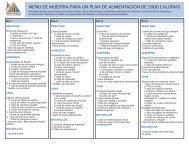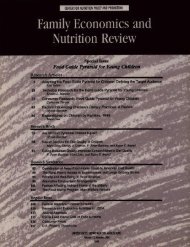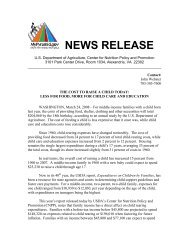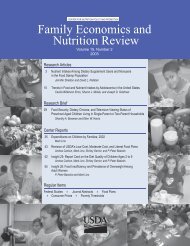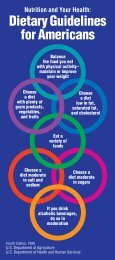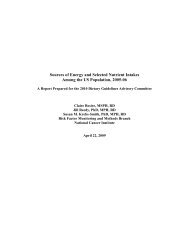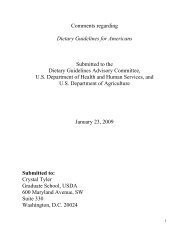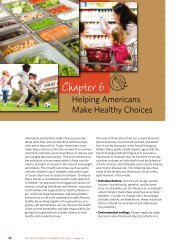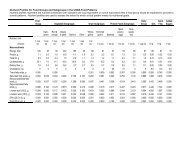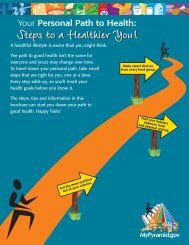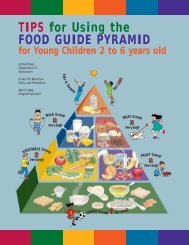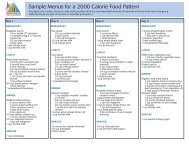Elderly Nutrition - Center for Nutrition Policy and Promotion - US ...
Elderly Nutrition - Center for Nutrition Policy and Promotion - US ...
Elderly Nutrition - Center for Nutrition Policy and Promotion - US ...
Create successful ePaper yourself
Turn your PDF publications into a flip-book with our unique Google optimized e-Paper software.
more risk factors than did Caucasian<br />
women (4.7 vs. 3.9).<br />
After the intervention, participants<br />
were asked whether they had made<br />
any changes related to osteoporosis<br />
risk since attending the educational<br />
lessons (table 3). Four of 10 reported<br />
that they had talked with their doctor<br />
about issues such as their heel BMD<br />
results <strong>and</strong> osteoporosis (41 percent<br />
each), a quarter had discussed prescription<br />
medications <strong>for</strong> osteoporosis,<br />
<strong>and</strong> about a quarter had discussed<br />
exercises <strong>for</strong> their bone health. A large<br />
number of participants increased their<br />
physical activity, practiced the balance<br />
exercises at home, <strong>and</strong> adopted at<br />
least one fall-prevention measure.<br />
Additionally, there were substantial<br />
increases in diet <strong>and</strong> supplement use,<br />
including eating more calcium-rich <strong>and</strong><br />
calcium-<strong>for</strong>tified foods, <strong>and</strong> starting to<br />
take supplements with either calcium or<br />
vitamin D. Despite a detailed discussion<br />
of low-lactose dairy foods, very<br />
few participants started using commercially<br />
available low-lactose milk<br />
(5 percent) or tried using lactase<br />
tablets or drops (2 percent).<br />
Discussion<br />
The nutrition <strong>and</strong> bone health<br />
curriculum that was designed <strong>for</strong><br />
low-literacy, low-income older adults<br />
reduced the number of modifiable<br />
osteoporosis-related risk factors <strong>and</strong><br />
was associated with other self-reported<br />
behavioral changes. The major findings<br />
at baseline were that a substantial<br />
number of participants had osteopenia<br />
or osteoporosis based on their heel<br />
BMD results. After the intervention,<br />
participants significantly decreased<br />
their osteoporosis-related risk factors<br />
score <strong>and</strong> were more likely both to<br />
consume calcium-rich foods <strong>and</strong> to use<br />
calcium supplements. However, the<br />
consumption of calcium-rich foods<br />
increased by a statistically significant,<br />
Table 3. Self-reported post-intervention changes related to modifiable osteoporosis-related<br />
risk factors: Adults in the Older Americans <strong>Nutrition</strong> Program<br />
but nutritionally small amount (2.5<br />
servings/week), translating to minor<br />
increases in daily calcium intake.<br />
There is a heightened awareness that<br />
African-American women are at risk<br />
<strong>for</strong> osteoporosis (Bohannon, 1999).<br />
Even though the mean heel BMD of<br />
women did not differ by ethnicity,<br />
it is possible that, compared with<br />
the Caucasian women, the African-<br />
American women in this study may<br />
be at somewhat higher future risk <strong>for</strong><br />
osteoporosis <strong>for</strong> two reasons: they<br />
were less likely to take a calcium<br />
supplement or any vitamin D-<br />
containing supplement, <strong>and</strong> they were<br />
more likely to have signs of lactose<br />
intolerance. However, our sample size<br />
was small, <strong>and</strong> it is not possible to<br />
reach a definitive conclusion on ethnic<br />
differences in the osteoporosis-risk<br />
profile of these participants.<br />
In addition to small sample size, there<br />
were other limitations in this study.<br />
Percent reporting<br />
risk factor<br />
Talked with doctor about<br />
BMD results 41<br />
Osteoporosis 41<br />
Prescription medications <strong>for</strong> osteoporosis 25<br />
Exercises <strong>for</strong> bone health 27<br />
Increased physical activity 39<br />
Practiced balance exercises at home 55<br />
Adopted at least one fall-prevention measure 34<br />
Dietary <strong>and</strong> supplement changes<br />
Ate more calcium-rich foods 30<br />
Ate more calcium-<strong>for</strong>tified foods 20<br />
Started taking calcium supplement 23<br />
Started taking vitamin D supplement 11<br />
Changed to low-lactose milk 5<br />
Tried lactase tablets or drops 2<br />
Note: n=59.<br />
The curriculum may not have<br />
accommodated varied levels of<br />
comprehension among the participants.<br />
Although we did not assess the<br />
educational level of this sample,<br />
we have found that the mean level<br />
of education is eighth grade in older<br />
adults receiving congregate meals<br />
from this same Area Agency on Aging<br />
(Brackett, 1999). To address concerns<br />
associated with comprehension, the<br />
educators reviewed <strong>and</strong> modified the<br />
curriculum be<strong>for</strong>e it was implemented.<br />
A question-<strong>and</strong>-answer period was<br />
included at the end of every lesson<br />
to allow participants to have their<br />
questions answered <strong>and</strong> to address<br />
issues that were not covered in the<br />
lessons. Also, not everyone attended<br />
all the lessons. To minimize the effect<br />
of absenteeism on behavior modification,<br />
instructors gave participants<br />
h<strong>and</strong>outs that repeated important<br />
concepts <strong>and</strong> emphasized selfempowerment.<br />
88 Family Economics <strong>and</strong> <strong>Nutrition</strong> Review



